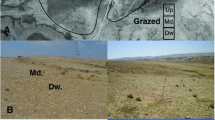Abstract
Impact of recreational activities on soil and vegetation was evaluated in eight forested camping and picnic areas in southern Rhode Island. Forest vegetation consists of mixed-oak and white pine stands. Soils are of granitic glacial till or outwash origin and textures range from loamy sand to find sandy loam. Recreational use resulted in significant compaction of soils as indexed by soil penetration resistance and bulk density. Evidence indicates that compaction influences bulk densities to a depth of about 12.7 cm. Rates of water infiltration are less on recreation areas. Soil water accretion and depletion during the growing season are less rapid on recreation sites than on control sites. Differences are attributed to reduced infiltration, percolation, and rooting activity. Much of the ground surface on recreation areas is devoid of vegetation. The surface consists primarily of bare mineral soil, rock, or litter. The plants most commonly present are grasses. Native ground cover vegetation including tree seedlings, ericaceous shrubs and herbs has been eliminated or greatly reduced by trampling. Damage to tree trunks is common in recreation areas. White pine radial growth and scarlet oak height growth were significantly less on recreation sites. Scarlet oak appears intolerant to heavy recreation use.
Similar content being viewed by others
Literature cited
Beardsley, W. B., and J. A. Wagar. 1971. Vegetation management on a forested recreation site. J. Forestry 69(10):728–731.
Brumbach, J. J. 1965.Climatological summary Kingston, R.I. R.I. Agri. Ext. Serv. Circ. 157. 2 pp.
Dotzenko, A. D., N. T. Papamichas, and D. S. Romine. 1967. Effect of recreational use on soil and moisture conditions in Rocky Mountain National Park. J. Soil and Water Conserv. 22(5):196–197.
Echelberger, H. E. 1971. Vegetative changes at Adirondack campgrounds 1964 to 1969. U.S. Forest Serv. Res. Note NE-142. 8 pp.
Fernald, L. M. 1950. Gray's manual of botany. American Book Company, New York. 1,632 pp.
Fletcher, P. W., and H. W. Lull. 1963. Soil-moisture depletion by a hardwood forest during drought years. Soil Sci. Soc. Amer. Proc. 27:94–98.
Kalisz, S. P., and J. H. Brown, Jr. 1976. Starch content of oak roots on campsites. Sci. of Biology J. 2:160–165.
Kienholz, R. 1934. Leader, needle, cambial, and root growth of certain conifers and their relationships. Bot. Gaz. 96:73–92.
LaPage, W. F. 1962. Recreation and the forest site. J. Forestry 60:319–321.
---. 1967. Some observations on campground trampling and ground cover response. U.S. Forest Serv. Res. Paper NE-68. 11 pp.
Lutz, H. J. 1945. Soil conditions on picnic grounds in public forest parks. J. Forestry 43:121–127.
Magill, A. W. 1970. Five California campgrounds—Conditions improve after 5 years' recreational use. U.S. Forest Serv. Res. Paper PSW-62. 18 pp.
Magill, A. W., and E. C. Nord. 1963. An evaluation of campground conditions and needs for research. U.S. Forest Serv. Res. Note PSW-4. 8 pp.
Merriam, L.C. Jr., and C.K. Smith. 1974. Visitor impact on newly developed campsites in the Boundary Waters Canoe Area. J. Forestry 72:627–630.
Settergren, C. D., and D. W. Cole. 1970. Recreation effects on soil and vegetation in the Missouri Ozarks. J. Forestry 68:231–233.
Thornthwaite, C. W. 1948. An approach toward a rational classification of climate. Geogr. Rev. 38:55–94.
Tryon, E. H., and R. P. True. 1958. Recent reductions in annual radial increments in dying scarlet oaks related to rainfall deficiencies. Forest Sci. 4:219–230.
Author information
Authors and Affiliations
Rights and permissions
About this article
Cite this article
Brown, J.H., Kallsz, S.P. & Wright, W.R. Effects of recreational use on forested sites. Environmental Management 1, 425–431 (1977). https://doi.org/10.1007/BF01866999
Issue Date:
DOI: https://doi.org/10.1007/BF01866999




